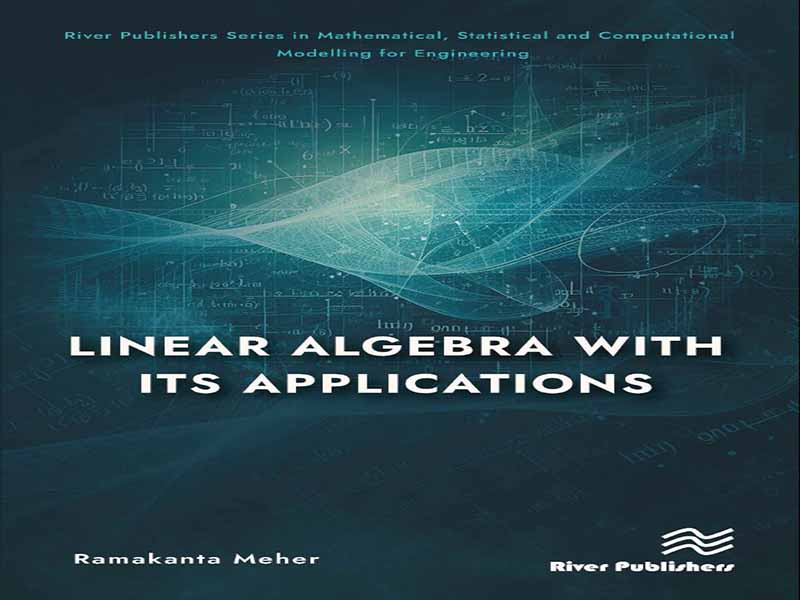جبر خطی نقش حیاتی در مطالعه انواع مختلف مسائل دنیای واقعی برای بررسی رفتار مسائل ایفا میکند. تعریفی از جبر خطی که ممکن است بخشی از جبر باشد، مربوط به معادلات درجه اول است. بنابراین، در سطح بنیادی، شامل بحث در مورد ماتریسها و دترمینانها و راهحلهای دستگاههای معادلات خطی است که کاربرد گستردهای در بحث بیشتر در مورد این موضوع دارند. جبر خطی موضوعی است که وسیعترین طیف کاربردها را در تمام شاخههای ریاضیات، علوم فیزیکی و اجتماعی و مهندسی پیدا کرده است. کاربرد آن در علوم اطلاعات و نظریه کنترل قابل توجهتر است. این کتاب با بحث مفصلی در مورد عملیات ماتریسی، خواص آن و کاربردهای آن در یافتن راهحل معادلات خطی و دترمینانها آغاز میشود. این کتاب درسی با عنوان جبر خطی با کاربردهای آن برای مطالعه ماتریسها، فضاهای برداری، مقادیر ویژه، بردارهای ویژه، روشهای تبدیل خطی، فضاهای ضرب داخلی، قطریسازیها، کاربردها در مخروطیها و چهارضلعیها، فرمهای متعارف و مسائل حداقل مربعات در نظر گرفته شده است. این کتاب شامل 11 فصل است. فصل ۱ به بررسی خواص ماتریسها و عملیات ماتریسی مورد نیاز برای مطالعه جوابهای دستگاههای معادلات خطی و دترمینانها میپردازد. فصل ۲ به بررسی دستگاه معادلات خطی و جواب آن با استفاده از روش حذف گاوسی، روش حذف گاوس-جردن و روشهای تجزیه LU و تعاریف دترمینانها به همراه خواص آنها و قانون کرامر میپردازد. در مقابل، فصل ۳ با بحثی در مورد فضاهای برداری در فضاهای برداری n بعدی آغاز میشود که شامل خواص یک فضای برداری و زیرفضاها، ترکیبهای خطی و پوشش یک فضای برداری، فضاهای برداری تولید شده متناهی، وابستگی و استقلال خطی، پایه و ابعاد، رتبه، مجموع و تقاطع زیرفضاها، مجموع مستقیم زیرفضاها و بیش از دو زیرفضا میشود. فصل ۴ به بررسی خواص مقادیر ویژه و بردارهای ویژه و برخی از خواص فضاهای ضرب داخلی، از جمله فرآیند متعامدسازی گرام-اشمیت و فاکتورگیری QR میپردازد. فصل ۵ به بحث در مورد تبدیل خطی میپردازد که شامل برد و هسته تبدیل، تبدیلهای یک به یک و معکوسپذیر، نمایش ترتیبی بردارها، تغییر مبنا، ایزومورفیسم، تبدیلها در گرافیک کامپیوتری و تصاویر فراکتالی طبیعت میشود. فصل ۶ به فضاهای ضرب داخلی میپردازد که شامل نابرابری کوشی-شوارتز، مکملهای متعامد، مجموعهها و پایههای متعامد، تصویر یک بردار روی بردار دیگر، قضیه ماتریس متعامد، فرآیند متعامدسازی گرام-اشمیت، تصویر یک بردار روی یک زیرفضا، فاصله یک نقطه از یک زیرفضا و فاکتورگیری QR میشود. فصل ۷ به نمایش ماتریسی تبدیلهای خطی به همراه اهمیت نمایش ماتریسی، تجسم نمایش ماتریسی و رابطه بین نمایشهای ماتریسی میپردازد. در مقابل، فصل ۸ به قطریسازیهایی میپردازد که شامل چندجملهایهای مینیمال، قضیه کیلی-همیلتون، توان یک ماتریس، نمایش ماتریسی قطری یک عملگر خطی، قطریسازی ماتریسها، قطریسازی ماتریسهای متقارن و قطریسازی متعامد میشود. فصل ۹ کاربرد این قانون در مخروطیها و چهارضلعیها را مورد بحث قرار میدهد که شامل فرمهای درجه دوم، مخروطیها، چهارضلعیها، فرم درجه دوم معین، فرم دوخطی، نمایش ماتریسی فرمهای دوخطی، فرم دوخطی متقارن و چوله-متقارن، فرمهای دوخطی متقارن و فرمهای درجه دوم، مقادیر ویژه ماتریسهای همنهشت، قانون اینرسی سیلوستر، فرم دوخطی چوله-متقارن و کاربرد آن در کاهش چهارضلعیها میشود. فصل 10 به بحث در مورد فرمهای متعارف میپردازد که شامل ماتریسهای مثلثیپذیر، ماتریسهای مثلثی بلوکی، قطریسازی بلوکی، ماتریسهای هرمیتی، ماتریس واحد، قضیه شور، قضیه طیفی، ماتریسهای نرمال، عملگرهای پوچتوان، فرم متعارف جردن، فرم متعارف گویا، چندجملهای کمینه و فرم متعارف جردن، فرم نرمال جردن، ویژگیهای ماتریس جردن و چندجملهای کمینه فرم نرمال جردن میشود. در حالی که فصل آخر، فصل 11، به مسائل حداقل مربعات میپردازد که تقریب توابع، تقریب فوریه، جوابهای حداقل مربعات، منحنیهای حداقل مربعات، مقادیر ویژه با تکرار و اتصال شبکهها، روش توانی برای یک ماتریس n × n، مشکلات در حل دستگاه معادلات، عدد شرط یک ماتریس و نظریه کدگذاری را پوشش میدهد. این کتاب بر اساس سرفصلهای جبر خطی است که برای دانشجویان کارشناسی و کارشناسی ارشد ریاضی در موسسات و دانشگاههای مختلف در هند و خارج از کشور تجویز شده است. این کتاب برای امتحانات رقابتی نیز مفید خواهد بود.
Linear algebra plays a vital role in studying different types of real-world problems to study the behavior of the issues. A definition of linear algebra that might be a part of algebra is concerned with equations of the first degree. Thus, at the fundamental level, it involves the discussion of matrices and determinants and the solutions of systems of linear equations, which have a wide application in further discussion of this subject. Linear algebra is a subject that has found the broadest range of applications in all branches of mathematics, physical and social sciences, and engineering. It has a more significant application in information sciences and control theory. This book begins with a detailed discussion of matrix operation, its properties, and its applications in finding the solution of linear equations and determinants. This textbook entitled Linear Algebra with Its Applications is intended to study matrices, vector spaces, eigenvalue, eigenvectors, linear transformation methods, inner product spaces, diagonalizations, applications to conics and quadrics, canonical forms, and least squares problems. This book contains 11 chapters. Chapter 1 discusses the properties of matrices and matrix operations needed to study solutions of systems of linear equations and determinants. Chapter 2 discusses the system of linear equations and its solution using the Gaussian elimination method, the Gauss–Jordan elimination method, and LU decomposition methods, and the definitions of determinants with their properties and Crammer’s rule. In contrast, Chapter 3 starts with a discussion of vector spaces in n-dimensional vector spaces that include the properties of a vector space and subspaces, linear combinations and spanning a vector space, finitely generated vector spaces, linear dependence and independence, basis and dimensions, rank, sum and intersection of subspaces, direct sums of subspaces, and more than two subspaces. Chapter 4 discusses the properties of eigenvalues and eigenvectors and some properties of inner product spaces, including the Gram–Schmidt orthogonalization process and QR-factorization. Chapter 5 discusses linear transformation, which includes Range and Kernel of transformation, one-to-one and invertible transformations, ordination representation of vectors, change of basis, isomorphism, transformations in computer graphics, and fractal pictures of nature. Chapter 6 discusses inner product spaces that include the Cauchy–Schwarz inequality, orthogonal complements, orthogonal sets and bases, projection of one vector onto another vector, orthogonal matrix theorem, the Gram–Schmidt orthogonalization process, projection of a vector onto a subspace, distance of a point from a subspace, and QR-factorization. Chapter 7 discusses the matrix representation of linear transformations along with the importance of matrix representation, visualization of the matrix representation, and the relation between matrix representations. In contrast, Chapter 8 covers the diagonalizations that include minimal polynomials, the Cayley–Hamilton theorem, power of a matrix, diagonal matrix representation of a linear operator, diagonalization of matrices, diagonalization of symmetric matrices, and orthogonal diagonalization. Chapter 9 discusses the application to conics and quadrics that covers quadratic forms, conics, quadrics, definite quadratic form, bilinear form, matrix representation of bilinear forms, symmetric and skew-symmetric bilinear form, symmetric bilinear forms and quadratic forms, eigenvalues of congruent matrices, Sylvester’s law of inertia, skew-symmetric bilinear form, and the application to the reduction of quadrics. Chapter 10 discusses the canonical forms that include triangularizable matrices, block triangular matrices, block diagonalization, Hermitian matrices, unitary matrix, Schur’s theorem, spectral theorem, normal matrices, nilpotent operators, Jordan canonical form, rational canonical form, minimum polynomial and Jordan canonical form, Jordan normal form, properties of Jordan matrix, and minimum polynomial of Jordan normal form While the last chapter, Chapter 11, discusses the least square problems that cover approximation of functions, Fourier approximation, least square solutions, least square curves, eigenvalues by iteration and connectivity of networks, the power method for an n × n matrix, difficulties in the solution of the system of equations, the condition number of a matrix, and the coding theory. This book is based on syllabi of linear algebra prescribed for undergraduate and postgraduate mathematics students in different institutions and universities in India and abroad. This book will be helpful for competitive examinations as well.
این کتاب را میتوانید از لینک زیر بصورت رایگان دانلود کنید:
Download: A Linear Algebra with its Applications



































نظرات کاربران